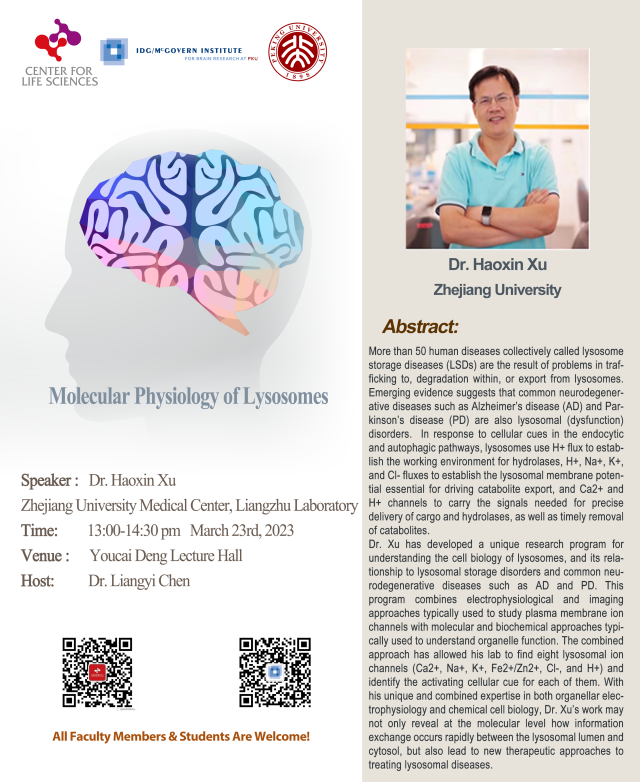题目:Molecular Physiology of Lysosomes
主讲:徐浩新教授
时间:2023年3月23日13:00-14:30
地点:金光生命科学大楼邓祐才报告厅
主持:陈良怡教授
主讲简介
徐浩新,本科毕业于北京大学生物化学专业,现良渚实验室和浙江大学求是讲席教授,基础医学院院长, 美国密歇根大学生物学系客座教授,溶酶体离子通道和疾病研究的世界领军人物。发起并担任首届高登会议(Gordon Research Conference)细胞器离子通道和转运蛋白会议主席,发起并担任首届中国溶酶体生物学大会会议主席, 国际药理学TRP通道分会主席。他长期从事神经生物学、细胞生物学、分子生物学等领域的教学和研究,迄今共鉴定12种未知离子通道蛋白,包括8个溶酶体离子通道蛋白。获美国青年科学家总统奖(PECASE),斯隆研究奖,密歇根大学杰出教授奖等奖项。发表高水平论文80余篇、 H-Index 54、 文章累计引用两万多次,包括《Nature》及子刊14篇、《Science》及子刊2篇、《Cell》及子刊8篇、《PNAS》9篇。生物和生化方向高被引(1%)学者。
个人主页:https://person.zju.edu.cn/0022106
报告摘要
More than 50 human diseases collectively called lysosome storage diseases (LSDs) are the result of problems in trafficking to, degradation within, or export from lysosomes. Emerging evidence suggests that common neurodegenerative diseases such as Alzheimer’s disease (AD) and Parkinson’s disease (PD) are also lysosomal (dysfunction) disorders. In response to cellular cues in the endocytic and autophagic pathways, lysosomes use H+ flux to establish the working environment for hydrolases, H+, Na+, K+, and Cl- fluxes to establish the lysosomal membrane potential essential for driving catabolite export, and Ca2+ and H+ channels to carry the signals needed for precise delivery of cargo and hydrolases, as well as timely removal of catabolites.
Dr. Xu has developed a unique research program for understanding the cell biology of lysosomes, and its relationship to lysosomal storage disorders and common neurodegenerative diseases such as AD and PD. This program combines electrophysiological and imaging approaches typically used to study plasma membrane ion channels with molecular and biochemical approaches typically used to understand organelle function. The combined approach has allowed his lab to find eight lysosomal ion channels (Ca2+, Na+, K+, Fe2+/Zn2+, Cl-, and H+) and identify the activating cellular cue for each of them. With his unique and combined expertise in both organellar electrophysiology and chemical cell biology, Dr. Xu’s work may not only reveal at the molecular level how information exchange occurs rapidly between the lysosomal lumen and cytosol, but also lead to new therapeutic approaches to treating lysosomal diseases.
